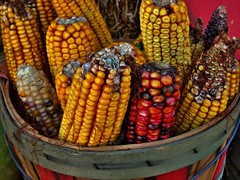How Eco-Friendly Monks Rekindled the Use of Spirits.
Saturday, September 26, 2009
The following is a guest post by Shireen Qudosi of Heater-Home
They say people in glass homes shouldn't throw stones. Well, this is one glass home you're not likely to find a squabbling pair in.
In 1984, Buddhist monks in Thailand began gathering bottles to decorate their shelters. The interest not only attracted a lot of tourists but also resulted in a flood of donated bottles to help the monks realize their luminary vision. Since then, Thai monks in the Siasaket province just 370 miles northeast of Bangkok have used approximately 1.5 million glass bottles to create their temple.
While many eco-enthusiasts have incorporated recycled bottles into their décor, these creative and dedicated monks have taken it to a whole new level. Using a mixture of green Heineken bottles and brown Thai beer bottles, the monks find that the use of bottles as building materials is a practical solution, since the bottles don't lose their color and are easily cleaned; plus the thickness of beer bottles makes them durable enough to resist wear and tear. The monks have also cleverly put beer bottle caps to good use by creating stunning mosaics depicting Buddha.
Moving beyond simple sustainability and to spiritual sustainability, Thai monks have taken beer, normally associated with common culture, and have created a cultural goldmine out of beer byproducts. They've single-handedly redefined recyclability, and raised the bar in an eco-conscious world. If a handful of monks with limited resources can create this, what about the rest of us? The Beer Bottle Temple is a testament to eco-living that fuses practicality and spirituality to create a whole new forum for aesthetic design.
The bottles create a structure that holds up the number-one rule in architecture, which calls for an awareness of how the building uses light. The "Beer Bottle Temple," as it's now referred to, draws every last bit of light in and reflects it throughout, creating a warm glow unmatched by electrical lighting. Imagine how a stained-glass church looks -- now imagine the incandescence of an entire building arising out of glass, with reams of sunlight stretching from wall to wall.
While it's unlikely that the rest of us have a glass house, we can certainly learn from the design element, and perhaps pick up a little green lesson. It's true that many modern homes (especially pre-fab and modular homes) have a larger percentage of windows. Though increased window space is always a scenic plus, it's usually not conducive to a warm, toasty home -- a much needed transition during the approaching winter months.
The fact is, glass does nothing to insulate your home, and switching on the heater to high is not the best idea if you want to go Earth-friendly and not be out of house and home after paying your heating bill. Rather than shoveling buckets of change into the bottomless pit known as utility bills, try investing in a space heater and keep that heater in the area you use most -- like your bedroom, office or living room. This way you're channeling the heat right where you need it, so that no matter where you live, your home can still be your castle.
As for the monks, they're still busy building. They continue to collect and receive empty bottles that they're now using for additional temples and shelters. The Beer Bottle Temple brilliantly reflects what a little bit of ingenuity and a lot of patience can accomplish. It is a monument to spiritual sustainability that also defies the cultural associations we've branded on spirits.
Have New Posts From Making Homemade Wine and Beer Delivered To Your Email

 Follow Me On Twitter
Follow Me On Twitter


